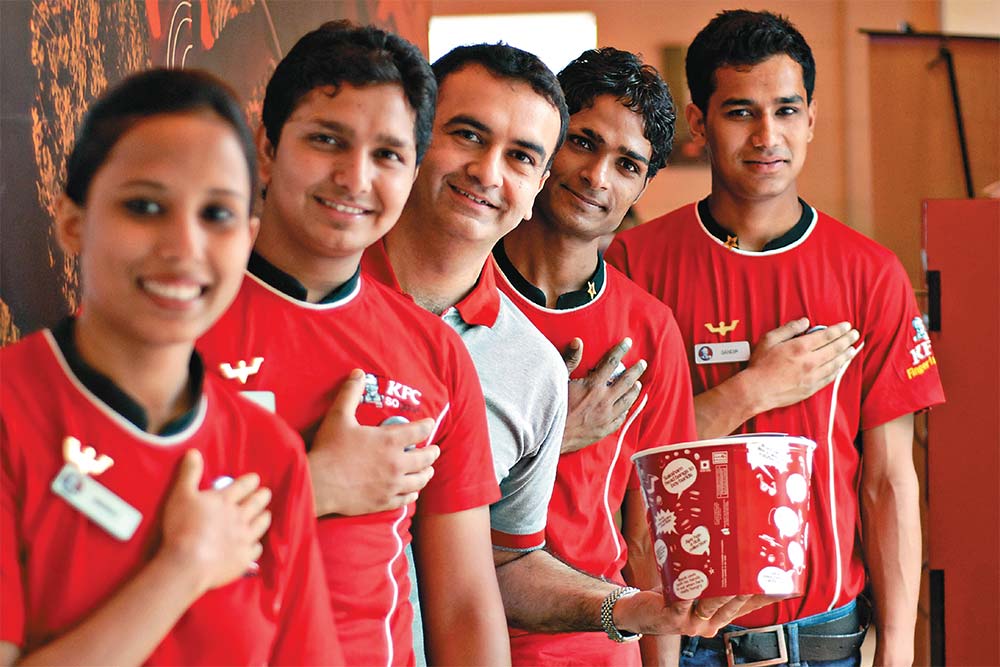For most young people in college, life is a sort of existential impasse — you are always broke, always hungry, and always in the canteen. Yet, even 15 years ago, it would have been ridiculous to imagine that a food chain born far away in southern United States would aspire to be the local college canteen but that’s exactly what is happening. KFC, the company that a certain Colonel Sanders started in 1930, is now in the race to satiate the perpetually rumbling stomach of the Indian collegian. Its new ad yells triumphantly: ‘KFC hai students ka naya adda.”
KFC’s evolution, in fact, appears to have followed the rise of India’s youth economy. Remember, the company’s mid-1990s debut was decidedly unceremonious — American companies were unwelcome, demonstrations were staged outside KFC outlets, and people who did manage to eat there found the food bland and unappetising, forcing most outlets to close down. The re-birth of the crispy fowl began in 2004 — the young Indian, now raised on a diet of satellite TV and the web, was eager for new and international experiences. By the time KFC relaunched in India with some snappy advertising and sub-₹100 menu items, next gen diners were ready for its famous chicken.
KFC’s ‘happeningness’ with its young crowd of regulars may appear casual and catchy but it’s actually the result of study and structuring, right down to its physical spaces. “Most people spend time in two locations — home and office,” says Sandeep Kataria, chief marketing officer, Yum Restaurants India, the company that owns KFC. “But college students and people who have just begun working are constantly on the move. This demographic spends the most time outside of these two locations and they tend to eat out a lot.” A fact confirmed by 19-year-old Kimaya Duggal, a student of Jesus and Mary College, New Delhi, who visits KFC thrice a week. “I go with friends after college twice a week for a late lunch around 4,” she says. “And then on the weekend I drag my mum along for a Zinger fix.”
Stay young
It follows that KFC’s restaurants are located in malls, popular markets and near large offices — catchment areas for the young crowds that throng it. “The other insight we had was that this group hunts in packs,” says Kataria. “So, our restaurants have booths, large tables, counter tops with high stools, and an elevated area — no matter what the group size, we provide a seating arrangement that’s suitable.”
Not surprisingly, KFC keeps everything youthful — from its store décor (bright colours, irreverent graffiti) to menu (fried chicken buckets, snack SKUs for the price conscious, grilled chicken for the health conscious, Zing Kong Boxes for people on the go). The idea, especially in societies like India, where there is a continuous push to achieve and accomplish, is to allow the young a little time to relax and enjoy. For 14-year-old Ankit Sood, a student of DPS Gurgaon, KFC is a reward for finishing his revisions on time. “I tell myself if I finish a certain number of chapters, I can treat myself to a KFC,” he smiles. It’s an image the company doesn’t want to dilute — which is why, even though young parents and small kids visit the restaurant, there aren’t any ‘happy meals’ or giveaway toys. In fact, KFC doesn’t use children in ads nor does it advertise on kids channels.
Pricing, of course, is even more crucial. The average amount young people in the 15-25 age group spend on a meal at KFC is ₹100-150. In a bid to compete with other fast food chains and match the parsimonious wallets of the college canteen crowd, in 2011, KFC introduced Streetwise (a range of snack dishes like burgers made with smaller buns for ₹25 apiece).
With the target age band and pricing sorted, the average KFC-liker, the company learnt, tends to have a 60-40 split in his order — 60% is inevitably his favourite dish but he’s willing to experiment with the rest of his stomach space. “This makes product innovation key,” says Kataria. For example, one of KFC’s largest selling product is Krushers, launched in 2009. In fact, a lot of product ideas for the constantly ongoing menu experiments come from customers and the very young workforce that mans KFC’s counters.
The little bit extra
There are 170 KFC outlets across India now and the company’s goal is to take this number to 500 by 2015. Its contemporary clientele is also helping the company beat the significant drawback of being a chicken restaurant in a country with over 30% vegetarians. Yum, which also runs the Pizza Hut and Taco Bell brands in India, is looking at a revenue target of a billion dollars in the next three years. Of this, 60% is expected to come from KFC.
In fact, a large chunk of the expansion over the next couple of years will come from smaller cities and towns. KFC has two challenges that could come in the way of its growth plans. One, as Kataria puts it is ‘first world costs and third world prices’. Real estate rentals are prohibitive in many cities and increasing the price of its offerings would, of course, be unwise. The other challenge lies in ensuring quality through its supply chain. When KFC launched its spicy hot wings in India, it ran into an acute problem — it was such a runaway success that the company was left wishing every chicken had more than two wings!











